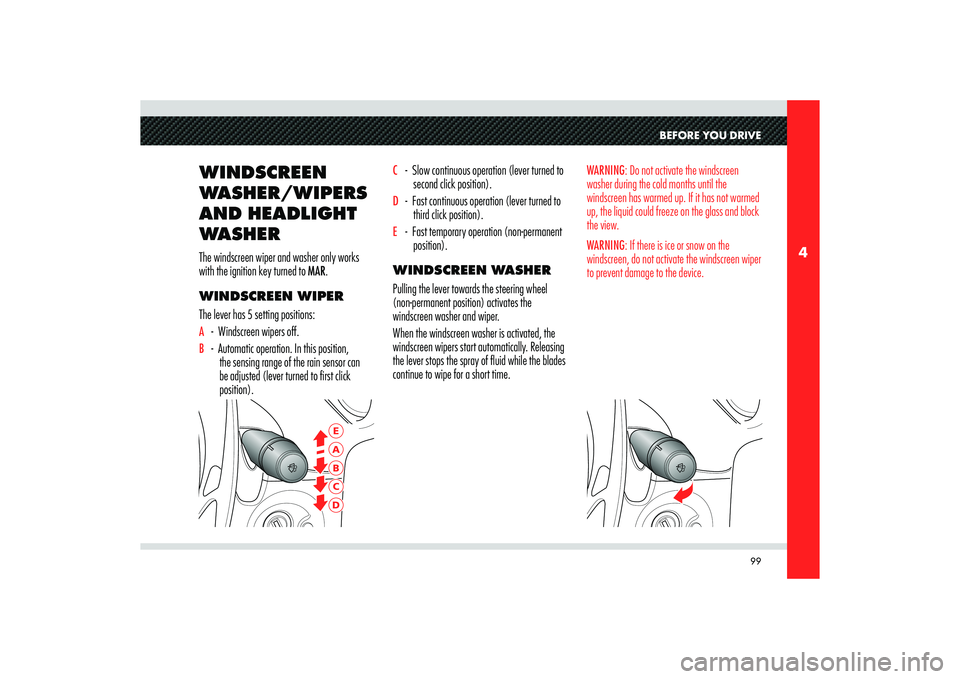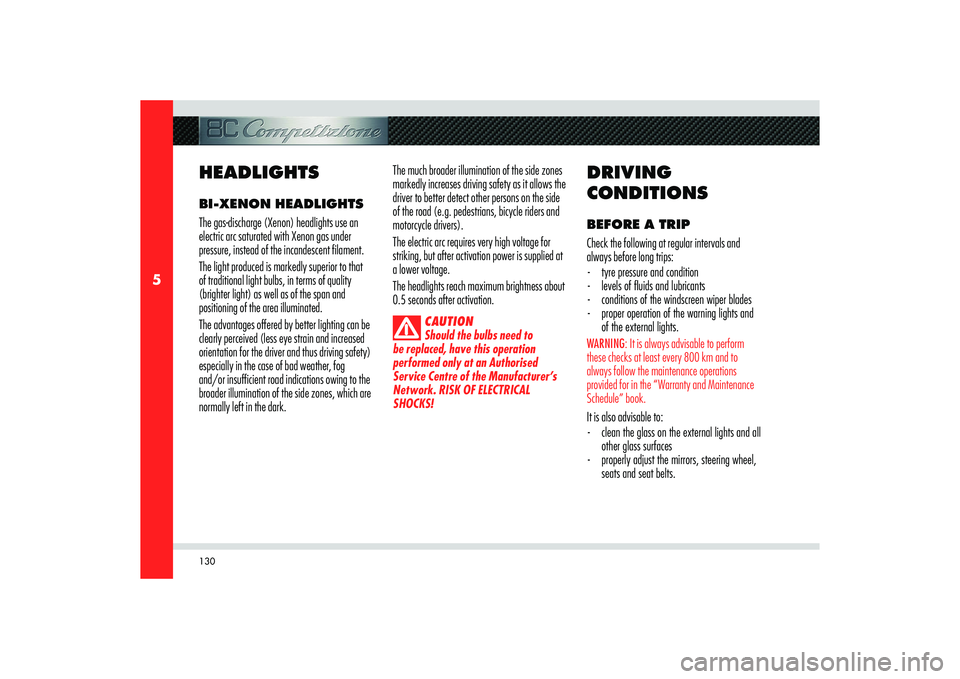wiper blades Alfa Romeo 8C 2007 Owner handbook (in English)
[x] Cancel search | Manufacturer: ALFA ROMEO, Model Year: 2007, Model line: 8C, Model: Alfa Romeo 8C 2007Pages: 223, PDF Size: 14.35 MB
Page 101 of 223

99
4
BAECD
BEFORE YOU DRIVE
WINDSCREEN
WASHER/WIPERS
AND HEADLIGHT
WASHERThe windscreen wiper and washer only works
with the ignition key turned to MAR.
WINDSCREEN WIPER
The lever has 5 setting positions:A - Windscreen wipers off.B - Automatic operation. In this position,
the sensing range of the rain sensor can
be adjusted (lever turned to first click
position).
C - Slow continuous operation (lever turned to
second click position).D - Fast continuous operation (lever turned to
third click position).E - Fast temporary operation (non-permanent
position).
WINDSCREEN WASHER
Pulling the lever towards the steering wheel
(non-permanent position) activates the
windscreen washer and wiper.
When the windscreen washer is activated, the
windscreen wipers start automatically. Releasing
the lever stops the spray of fluid while the blades
continue to wipe for a short time.
WARNING: Do not activate the windscreen
washer during the cold months until the
windscreen has warmed up. If it has not warmed
up, the liquid could freeze on the glass and block
the view.
WARNING: If there is ice or snow on the
windscreen, do not activate the windscreen wiper
to prevent damage to the device.
Page 132 of 223

130
5
HEADLIGHTSBI-XENON HEADLIGHTS
The gas-discharge (Xenon) headlights use an
electric arc saturated with Xenon gas under
pressure, instead of the incandescent filament.
The light produced is markedly superior to that
of traditional light bulbs, in terms of quality
(brighter light) as well as of the span and
positioning of the area illuminated.
The advantages offered by better lighting can be
clearly perceived (less eye strain and increased
orientation for the driver and thus driving safety)
especially in the case of bad weather, fog
and/or insufficient road indications owing to the
broader illumination of the side zones, which are
normally left in the dark.The much broader illumination of the side zones
markedly increases driving safety as it allows the
driver to better detect other persons on the side
of the road (e.g. pedestrians, bicycle riders and
motorcycle drivers).
The electric arc requires very high voltage for
striking, but after activation power is supplied at
a lower voltage.
The headlights reach maximum brightness about
0.5 seconds after activation.
CAUTION
Should the bulbs need to
be replaced, have this operation
performed only at an Authorised
Service Centre of the Manufacturer’s
Network. RISK OF ELECTRICAL
SHOCKS!
DRIVING
CONDITIONSBEFORE A TRIP
Check the following at regular intervals and
always before long trips:
- tyre pressure and condition
- levels of fl uids and lubricants
- conditions of the windscreen wiper blades
- proper operation of the warning lights and
of the external lights.WARNING: It is always advisable to perform
these checks at least every 800 km and to
always follow the maintenance operations
provided for in the “Warranty and Maintenance
Schedule” book.It is also advisable to:
- clean the glass on the external lights and all
other glass surfaces
- properly adjust the mirrors, steering wheel,
seats and seat belts.
Page 135 of 223

133
5
USING THE VEHICLE
- Use the high beams only outside of urban
areas and when you are sure that they will
not disturb other drivers.
- When another vehicle is approaching,
switch the high beams (if on) to low
beams.
- Keep the lights and headlights clean.
- Outside urban areas, beware of animals
crossing the road. DRIVING IN THE RAIN
Rain and wet roads are dangerous. On a wet
road all the manoeuvres are more difficult since
wheel grip on the asphalt is significantly reduced.
This means that the braking distances increase
considerably and the road holding decreases.
Certain advice for driving in the rain follows:
- Reduce your speed and keep a greater
safety distance from the vehicles in front
of you. High speed may result in a loss of
control and aquaplaning.
- Heavy rain also substantially reduces
visibility.
- Set the Air Conditioning controls to
demisting, in order to avoid any visibility
problems.
- Periodically check the conditions of the
windscreen wiper blades. DRIVING IN FOG
If the fog is dense avoid travelling where
possible.
When driving in mist, blanket fog or when there
is the possibility of banks of fog:
- Keep a moderate speed.
- Turn on the rear fog lights. Do not use the
main beam.
- Remember that fog creates dampness on
the asphalt and thus any type of manoeuvre
is more diffi cult and braking distances are
greater.
- Keep a safe distance from the vehicle in
front of you.
- Avoid sudden changes in speed as much as
possible.
- Whenever possible, avoid passing other
vehicles.
- If you are forced to stop the vehicle
(breakdowns, impossibility of proceeding
due to poor visibility, etc.), fi rst of all, try to
stop off of the travel lane. Then turn on the
hazard warning lights and if possible, the
low beams.
Page 204 of 223

202
8
CAUTION
During the tyre life, the rolling
direction of the first fitting shall
always be observed, also in case of
“non-directional” tyres.
CAUTION
Check the depth of the tyre
tread at regular intervals (minimum
allowed value 1.6 mm). The thinner
is the tread, the greater is the risk of
skidding.
CAUTION
Drive carefully on wet roads to
decrease the risk of aquaplaning.
WINDSCREEN
WIPERSClean the rubber parts regularly using the
appropriate products.
Change the blades if the edge of the rubber
is deformed or worn. In any case, the blades
should be changed about once a year.
CAUTION
Travelling with worn wiper
blades is very dangerous because it
reduces the visibility in the event of
poor atmospheric conditions.
CAUTION
The arms of the wiper blade
have to be replaced with new ones
after having disassembled them twice.
The special arm fixing system ensures
optimal mechanical stability only after
the first two refitting operations,
provided that the specified tightening
torque is observed.CAUTION
We advise you to have any
operations involving removal of the
windscreen wiper arms performed at
an Authorised Service Centre of the
Manufacturer’s Network.
Some simple measures may reduce the
possibility of damage to the blades.
- In the case of temperatures below zero °C,
check that ice has not stuck the rubber part
against the windscreen glass. If necessary,
release with an anti-ice product.
- Remove any snow on the windscreen: as
well as protecting the blades, this avoids
forcing and overheating the electric motor.
- Do not activate the windscreen wipers when
the windscreen is dry.
Page 205 of 223

203
8
B
A
C
MAINTENANCE
SPRAY NOZZLES
If the jet does not work, first check that there
is fluid in the pan (see “Level checks” in this
section) then check that the nozzles are not
clogged.REPLACING THE WIPER
BLADES
1) Release the blade
A by lifting the catch
B.
2) Slide the blade
A to the right to remove it
from the arm. C.
3) Fit the new blade working in reverse order.
WARNING: When replacing the blade, be careful
not to damage the bodywork or the blade itself.
AIR
CONDITIONING/
HEATING SYSTEMDuring the winter, the air conditioning system
should be operated at least once a month for
about 10 minutes.
Before the summer season, have the system
efficiency checked at an Authorised Service
Centre of the Manufacturer’s Network. WARNING: The system uses R134a type
coolant that, in the event of accidental leakage,
is not harmful for the environment. Under no
circumstances should you use R12 fluid that, in
addition to being incompatible with the system
components, contains chloro-fluoro-carbons
(CFCs).
Page 209 of 223

207
8
MAINTENANCE
the Authorised Service Centres of the
Manufacturer’s Network). Do not use
thick plastic sheets, which do not allow
the humidity on the vehicle surface to
evaporate.
- Infl ate the tyres up to a pressure which
must be 0.5 bar higher than the normally
prescribed one, and check it at regular
intervals.
CAUTION
The tyre pressure must be
brought back to the prescribed value
before reusing the vehicle.
- Do not drain the engine cooling system. BATTERY CONDITIONER
SOCKET
Located under the left-hand seat, it can be
accessed by moving the seat forward and folding
down the backrest.
IF THE VEHICLE
IS LAID UP FOR
LONG PERIODS- If the vehicle is not used for several months,
take the following precautions:
- Wash and dry the vehicle thoroughly.
- Store the vehicle in a covered, dry and, if
possible, ventilated area.
- Engage a gear.
- Disconnect the battery (see page 168).
- Check the battery charge condition. This
check should be carried out monthly while
the vehicle is idle. Recharge the battery if
the load-free voltage is below 12.5 V.
- Check that the electric parking brake is not
applied.
- Clean and protect the painted parts applying
protective waxes.
- Clean and protect polished metal parts with
specifi c products available on the market.
- Talc the windscreen wiper blades and raise
them from the windscreen.
- Cover the vehicle with a fabric sheet
to allow transpiration (available at all
Page 221 of 223

219
9
TABLE OF CONTENTS
If there are injured persons ............................ 171
First aid kit .................................................. 172
Capacities and technical specifi cations ...... 175
Fuel ................................................................176
Engine oil ........................................................176
Capacities: quantity and speci� cations of the
products to use .............................................177
Capacities and recommended products ............. 177
Fuel consumption .............................................179
Fuel consumption following the 2004/3/EC
directive (litres per 100 km) ....................... 179
CO2 exhaust emissions .....................................179
CO2 emissions according to Directive
2002/80B/EC (g/km) ............................ 179
Technical speci� cations .....................................180
Engine ........................................................ 180
Injection – Ignition ....................................... 180
Lubrication system ....................................... 181
Cooling system ............................................ 181
Transmission ................................................ 181
Gearshifting ................................................. 182
Brakes ........................................................ 182
Suspension ................................................. 183
Steering ...................................................... 183
Wheels ....................................................... 183
Performance ................................................ 184Weights ...................................................... 184
Dimensions ................................................ 185
Tyre pressure ...................................................186
Maintenance .......................................... 189
Scheduled Maintenance ....................................190
After the 11
th service ................................... 190
Additional checks .............................................192
WARNING - Engine oil .................................... 192
WARNING - Air fi lter ..................................... 192
Level checks ....................................................193
Engine oil .................................................... 194
Gearbox oil ................................................. 195
Engine coolant ............................................. 195
Windscreen/headlight washer fl uid ................. 195
Power steering fl uid ...................................... 196
Brake fl uid ................................................. 196
Air � lter ..........................................................197
Anti-dust/anti-pollen � lter ...............................197
Battery ............................................................198
Useful hints for extending the life
of the battery ........................................... 198
Electronic control units .....................................199
Spark plugs .....................................................200
Wheels and tyres .............................................200
How to use the tyres .................................... 201Windscreen wipers ...........................................202
Spray nozzles .............................................. 203
Replacing the wiper blades ............................ 203
Air conditioning/heating system .......................203
Bodywork ........................................................204
Protection from atmospheric agents ................ 204
Tips for keeping the bodywork in good
condition .................................................. 204
Engine compartment ..................................... 205
Interiors ..........................................................206
Cleaning the leather upholstery ...................... 206
Leather upholstery treatment ......................... 206
Carbon parts ................................................ 206
If the vehicle is laid up for long periods ............207
Battery conditioner socket ............................. 207
Restarting the vehicle .................................... 210
Re-connecting the battery .............................. 211
Radio-frequency remote control: Ministerial
homologation ..............................................211
Conversion table ..............................................212
Table of contents .................................... 215
Table of contents ..............................................216